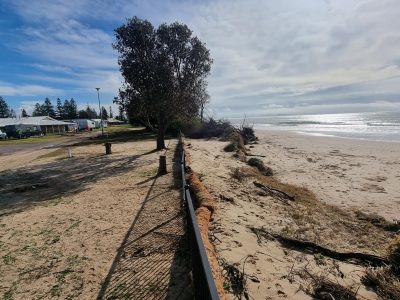Coastal Inundation: A Hazard Not to be Underestimated
Sixty years ago, I had my first encounter with overwash deposits resulting from storm surges along the Gulf of Mexico in southwest Louisiana and Texas. It was a revelation. I had just commenced graduate studies at Louisiana State University (LSU). The literature had alerted me to these features. However, to be on the ground and see their scale and to learn about impacts was something else. In more recent years, Gulf shores have received surges from several hurricanes. For instance, Hurricane Ike struck this coast in September 2008 and its impacts were documented in some detail by M. Byrnes and R. McBride in 2009 (Shore and Beach, vol. 77, no.2, 37-46). They showed considerable damage from flood inundation to buildings and infrastructure, not just from the surge but also from rapid overland runoff back to the sea.
In 2013, I visited the coast of New Jersey and Staten Island to witness the aftermath of Hurricane Sandy with a former college from LSU, Norb Psuty. This was a further revelation but of a horrific nature. I recommend anyone who wants to get a visual impression of damage from coastal inundation to Google Hurricane Sandy and take in the various links. The power of the surge in overtopping dunes and seawalls was incredible, as well as impact of return flows. I have just finished reading an excellent case study by A. Hatzikyriakou and N. Lin on damage assessment with implications for improving management strategies (“Assessing the vulnerability of structures and residential communities to storm surge: an analysis of flood impact during Hurricane Sandy”, Frontiers in Built Environment, 6 February 2018, online). They reached several conclusions. One relates to the failure to maintain dune capacity through beach nourishment. Another concerned building design requirements. They argued for authorities to look more at structures that are most likely to be damaged in measuring effectiveness of future mitigation strategies. Sounds obvious but the scale at which they worked highlighted what could be done better.
I have previously blogged on washover deposits of Holocene age along the southeast coast of Australia (Blog 125 on backbarrier flats 30/11/2018). Morphostratigraphic work highlighted the power of surges overtopping low dunes around the time sea level was reaching its present position. The relation between offshore slope and sand supply to wave energy during the late phase of the Postglacial Marine Transgression and early “stillstand” was different to present-day conditions. These deposits have many similarities to those observed along the Gulf of Mexico today. However, with continued sea level and no additional offshore sand supply we may see more frequent inundation events like that experienced in the USA.
Recent east coast storms are a reminder of just how important it is to understand vulnerability to coastal inundation. Dramatic photos taken during the 2016 storm at Collaroy is an example, although we know from history that surges occurred in this area. More recently, images have appeared from around Stockton of the storm on 2 April. I am very grateful to Philippa Hill of Newcastle City Council who has forwarded to me the photos and video attached to this blog. Ron Boyd kindly contributed a photo of the caravan park overwash.

 Coastal Inundation, Stockton Newcastle – Courtesy of Philippa Hill, Newcastle City Council
Coastal Inundation, Stockton Newcastle – Courtesy of Philippa Hill, Newcastle City CouncilNSW coastal legislation and manual refers to coastal inundation as one of the seven coastal hazards. Understanding where such impacts will take place now and into the future should form a component of coastal vulnerability assessment (CVAs). Overtopping dunes or seawalls is not just a time for amusement as seen in the video; such events can have serious consequences. As in New Jersey, there are many streets with homes and businesses that serve as funnels for powerful surges. Furthermore, many properties are slab-on-ground or within easy reach of a metre or so of marine flooding. Mapping such locations and assessing risk is something that banks and insurers will be increasingly alert to. As in the case of Stockton (and in New Jersey), such risks could be linked to programs of beach nourishment and dune maintenance including vegetative cover.
I fear that we have not fully appreciated potential damage to sections of our built environment from coastal inundation. Lots of attention has been directed to coastal erosion and recession, but where they can be coupled with overwash and flooding, the scale of damage will rise considerably. Properties and infrastructure lying at elevations less than 3m AHD sitting behind dunes (and seawalls) are in my opinion are going to be at increasing risk of being inundated and even isolated as has occurred overseas.
Bruce Thom
Words by Prof Bruce Thom. Please respect the author’s thoughts and reference appropriately: (c) ACS, 2022. For correspondence about this blog post please email admin@australiancoastalsociety.org.au
#222



 Beach Access – An International Perspective
Beach Access – An International Perspective